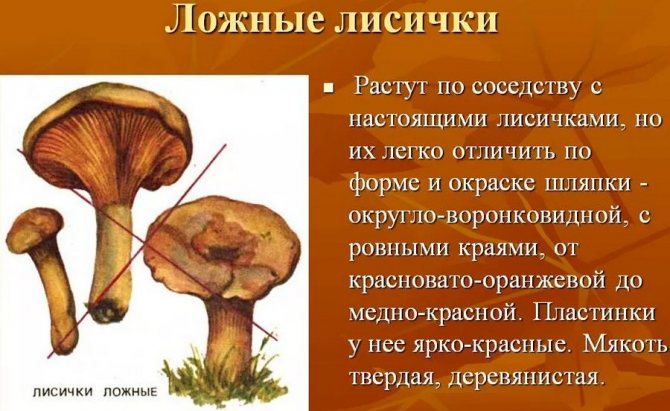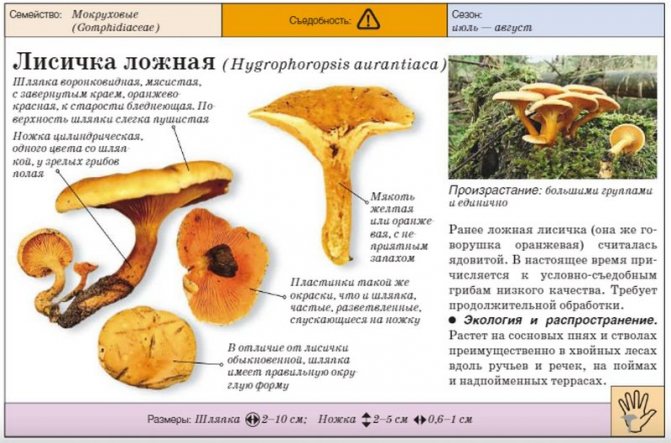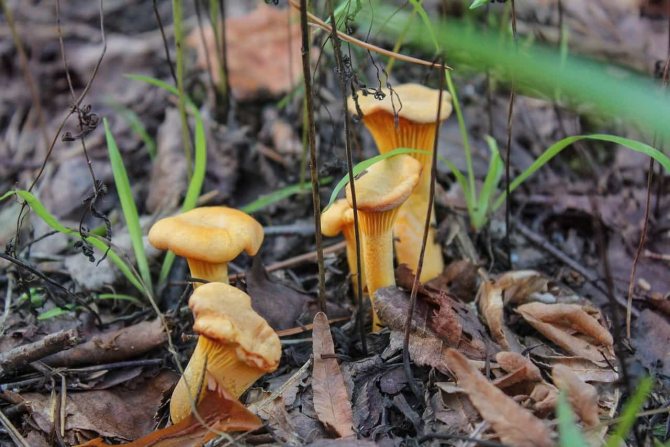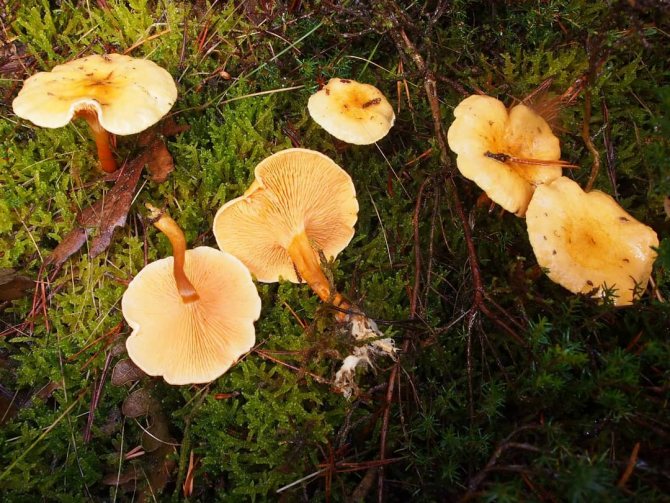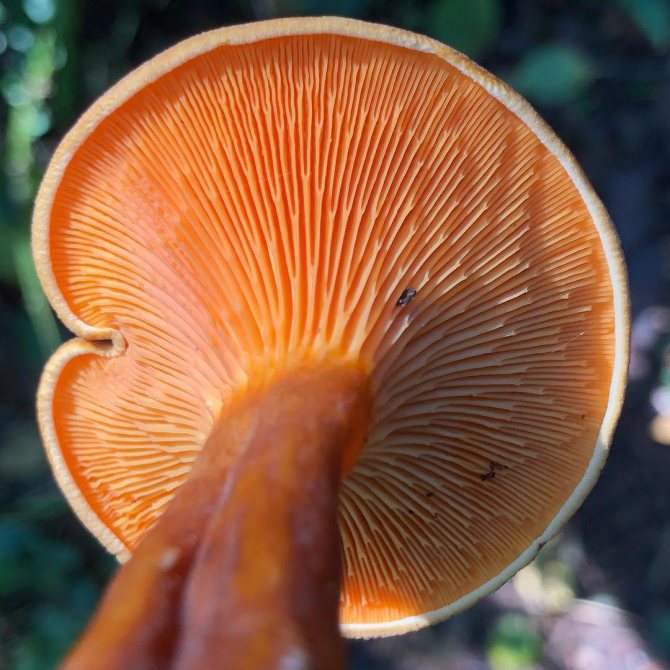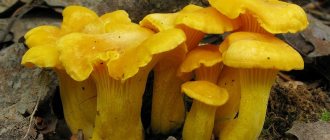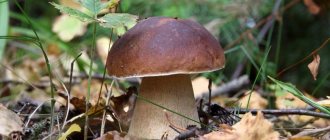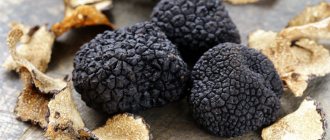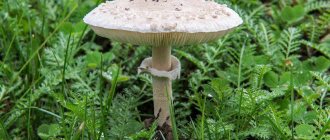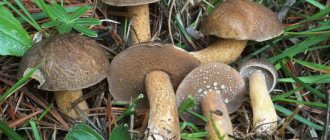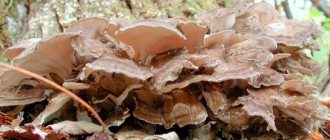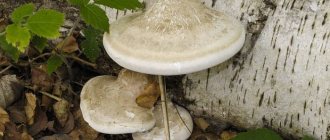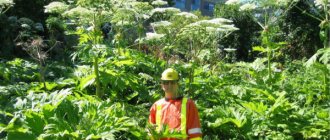3.6 / 5 ( 14 votes)
The false chanterelle is a representative of the Gigroforopsis family, often found in the forests of the northern hemisphere of the planet and is also called the orange talker. There is only a slight similarity between real chanterelles (cockerels) and false (cocks), but an inexperienced mushroom picker can put both the first and the second in the basket. Therefore, the question of how to distinguish false specimens from edible ones worries many people who like to eat the gifts of the forest.
First of all, you need to remember that even if several talkers fall into a basket with edible mushrooms, you should not worry. Because, knowing how to distinguish false chanterelles from real ones, it will be possible to get rid of unwanted specimens by cleaning and processing them. Despite the fact that the surface of the talker is the same color as the cap of the edible specimens, the rest of the mushrooms have different features.
Edible species of chanterelle mushrooms
Mushrooms have an unusual taste that other mushrooms do not have.
This uniqueness makes the forest gift desirable for lovers of quiet hunting. Despite the common characteristics of the family, there are different types of the same fungus.
The common species has become quite popular among all subgroups. This variety belongs to the edible and useful finds of foresters. Its upper dome usually grows and increases in size. In the family, you can find different heads: from 2 to 10 cm. The color of the hat merges into red. On closer inspection, it allows you to see a different range. Starting from a pale yellow tone, ending with a dark bright orange. It tastes slightly sour.
The skin is difficult to separate from the body. The pulp is yellow at the edges, paler by tone at the sections. The leg is the same color as the dome head.
Its thickness is 1-3 cm, and its length is 4-7 cm. It is important to know that due to the presence of the substance chinomannose in the content of the pulp, the fungus does not attract pests, worms, insects bypass the forest gift. This subspecies usually grows in deciduous and coniferous forest belts. Growth time is the beginning of summer (June) and until the end of August.
Chanterelle white
Mushroom pickers also call these subgroups "light" or "pale". This type belongs to edible and useful varieties.
- The volume of the white chanterelle's cap is usually from 2 to 5 cm, but there are also "giant" domes, the size of which reaches 10 cm. A distinctive feature of the white chanterelle is the shape of the cap. It is funnel-shaped with sinuous edges. The leg of the mushroom is yellowish. In length up to 5 cm, and in thickness up to 1-2 cm. The bottom of the leg usually resembles a cylinder, the top is tapered.
- The pulp of this subspecies is dense. Unfortunately, this is a rather rare variety.
It is not so easy to meet them, however, they are very tasty, so they are looking for them, hoping for a successful result.
Chanterelle white
Black chanterelles
This is a distant relative of the common chanterelle. However, they are very different in appearance. The mushroom is dark in color, resembling soot or charcoal in description.
- The diameter of the upper part reaches 8 cm. The pulp is tubular. The edges are uneven. The base is 1-2 cm long, gray in color. Stiff leg, slightly narrowed at the mycelium.
- Spore powder is white. The body of the black chanterelle is gray, brittle and absolutely does not smell.
The black chanterelle harvesting season starts in July and ends in September. It grows in deciduous or mixed forests. They grow in small groups.
How to distinguish a false fox from a real one (video)
Faceted chanterelle
This mushroom is very common in the forests of North America.
The body shape of the faceted chanterelle is funnel-shaped, with a diameter of 3 to 10 cm and has a dark orange color.
- The upper part looks like a hat with wavy edges hanging down. Although the flesh of the mushroom is quite dense, it is very fragile and with a rather pleasant smell.
- The size of the leg is about 2 - 2.5 cm. The mushroom can grow both in groups and singly. The season of the faceted chanterelle begins in summer and ends in early autumn.
Faceted has some special food qualities. The fact is that it includes paintings, thanks to which it prevails over some edible mushrooms and even some vegetables.
In addition, this type of chanterelle has a number of medicinal properties and qualities. It is used by obese people. Some substances from the content of the faceted variety help with acute inflammations. It has immunostimulating and antitumor properties.
Faceted chanterelle
Such a group has several more lows: the lobe is tubular, funnel-shaped. The upper part is small in size, usually reaches 5 cm. If the mushroom is young, then its cap is even, slightly convex. In adult specimens, it is already more acute, has a funnel-shaped shape.
- The skin is covered with small scales, to the touch it is similar to a dark velvet fabric. The tone of the hat is always different, rarely in the same family - one color. It is both dark, yellow and bright orange. It has various shades from the brown color palette.
- The base of the mushroom bowl is cylindrical, thin in volume, and sometimes bends. In height it reaches from 3 to 8 cm. In thickness - from 5 to 10 cm.
- The color of a thin leg can be light yellow, however, in the place where the cap passes into the leg, the shade is always darker, which is noticeable even with the naked eye.
- The flesh is firm, but very thin. Usually has a yellow or white tint. In addition, the flesh of a young tubular chanterelle is very tasty and has an unusual aroma. The pulp in an adult specimen is bitter.
You can find such a chanterelle in northern forests with a temperate climate.
Usually these are coniferous forests. They grow in the shade or on moist soils. It is difficult to find her, as she hides among the moss and grass. Begins to bear fruit in August, the latter are found in September. From this variety, you can cook a delicious soup, prepare a dry powder, fry, marinate or freeze for the winter. It is considered a delicacy.
Chanterelle velvety
This type of chanterelle is very rare.
... It is edible.
- The hat of this species is velvety. It measures from 4 to 5 cm. In small finds, the dome is convex, while in adults it transforms and becomes more like a funnel.
- In height, the leg is small 2-3 cm, rarely, but it can rise up to 7 cm.At the ground, it is slightly narrowed.
- The color of the cap is always different. It can be either bright orange, red or light yellow. Due to the fact that the edges of the cap are wavy, the mushroom becomes curly. The content of the mushroom is delicate and velvety. It has a pleasant aroma, but it tastes a little sour.
Velvety is a lamellar species.
The plates are thick and rough. There are streaks between them. This mushroom is very demanding on the climate and soil. You can find them in the southeast of the European Territories. They are usually harvested from mid-July to October. The value of the nutritional characteristics of such a forest find is as high as possible. They are very often used in culinary recipes, they are full of healing ingredients and a special pleasant taste. Chefs prepare real masterpieces from them.
Chanterelle velvety
Yellow chanterelles
The hat of this type is orange-yellow, and sometimes the color of egg yolk.
- The dome is convex, elongated and flat, depending on the growth time. The size of the upper part is from 5 to 10 cm.
- The skin is smooth to the touch, with wavy, rounded edges.
- The flesh of the body of the mushroom is dense and always the same color as the dome.
It tastes different from others: a little spicy, with a pleasant forest smell. The spore powder becomes yellow after processing. The harvesting season for this subspecies begins in June and ends in late autumn. They grow in forests with different types of trees: mixed and deciduous forest areas. They hide in mosses, grass, on damp soils.
Yellow chanterelles
Where orange talkers grow

Chanterelle and false chanterelle grow in different parts of the forest. However, they prefer coniferous and mixed plantings, high humidity and warm conditions. The common chanterelle forms mycorrhiza with various trees - pine, spruce, beech, oak. The main ripening period is in early June, then from August to mid-autumn.
The orange talker is found on the forest floor. She does not need symbiosis with trees. The false chanterelle grows in deciduous and coniferous areas. Rotting wood and leaves become a food source. Often the yellow forest beauty is found in moss or near anthills. Mushrooms are harvested in the temperate climates of Europe and Asia.
The orange talker mushroom is actively developing after the rains. With increasing humidity and temperature, favorable conditions for growth are created. Fruit bodies are found near streams, lakes, rivers. In drought and after frost, the likelihood of meeting a false fox is lower.
The false chanterelle grows singly or in large groups. The mycelium bears fruit annually. Ripening begins in August and lasts until November. Most mushrooms are found in mid-August and September.
How to distinguish false chanterelles from true ones
As it turned out, the chanterelle is a very cunning mushroom that explains its name.
You need to know very well its characteristics in order to distinguish poisonous false foxes from true edible representatives of the family.
- The first difference is in color and shape. You can immediately identify a false mushroom or not. The real color is usually attractive: yellow, orange, cream. False look very bright, defiant and frightening. These are usually brown, fiery orange hues.
- You can also distinguish a false chanterelle on the surface of the cap. In the “false fox”, it is smooth, even and clean. Up to 6 cm in size. A real chanterelle has a large dome, the shape always does not have the correct outlines, the edges are wavy.
- You can distinguish a chanterelle by the base - the leg. Experienced mushroom pickers first of all study it for density. If it is thick and rather sturdy, they are in front of a genuine specimen. And if the leg is thin and hollow inside, then this is a dangerous double.
Memo to mushroom picker
So, the main differences between edible and false chanterelles:
| False (orange talker) | Real chanterelle | |
| Color | Copper red, orange | Light, calm tones |
| Hat | Smooth bottom | Wavy everywhere |
| Leg | Empty, thin, wormy | Thick, filled, resilient |
| Controversy | Whitish | Yellowish |
| Smell | Unpleasant, gives off rot | Pleasant aroma |
| A place | Fallen tree, anthill | Stumps, mossy patches, old foliage |
| A family | Lonely, sometimes together | Grow together |
| Pulp | Yellow. Wormy. When pressed, nothing happens | White and yellow. Turns red when pressed |
If you spot a bright orange hat, take a close look and sniff the mushrooms. It is easy to distinguish chanterelles from false mushrooms, you need to be careful when collecting.
Gallery: chanterelle mushrooms (50 photos)
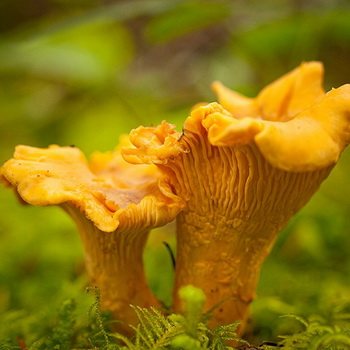

Chanterelles are very healthy and tasty mushrooms. They have a number of properties - they have an anthelmintic effect, improve liver function, and remove radioactive substances from the body. In addition, chanterelles contain a huge amount of vitamin C, polysaccharides and carotene.
False chanterelles
do not possess such properties. True, they cannot be called poisonous either.They belong to the group of conditionally edible mushrooms that can be eaten only after pre-soaking and heat treatment. They have no useful properties, and their taste leaves much to be desired. False chanterelles have another name - orange talkers.
Differences of false chanterelles
from the real ones in their appearance and habitat.
Mushroom and cap shape
False chanterelles, unlike real ones, have an even cap with rounded edges. And the size of the talker's hat differs from the chanterelle's hat. The head of the false mushroom is small, about 5 cm in diameter. The cap of the young false chanterelle is slightly convex, and the adult mushroom has a funnel-shaped cap. The surface of the talker's hat is velvet.
A real chanterelle always has a hat with uneven wavy edges. And the cap itself is almost twice as large as that of the false chanterelle - about 12 cm in diameter. In addition, the cap of a real chanterelle is smooth, and not rough, like that of a false one.
Mushroom plates
The false chanterelle always has very frequent and thin plates. They have a bright orange hue. The plates never pass to the leg, but only reach it.
And finally, one more piece of advice. Chanterelles are not suitable for drying, as they always remain soft. And here is the chanterelle marinade - perfect!
Chanterelles are mushrooms that can be found all over the world. Gourmets appreciate them for their excellent taste. These macromycetes are not easy to cultivate. Therefore, people collect them in the forest. However, there is a mushroom that looks like a chanterelle. And not just one. Therefore, "quiet hunters" must be able to distinguish between these macromycetes.
Orange talker (kokoshka)
This chanterelle-like mushroom has an external resemblance to it. For a long time, the orange talker was considered inedible or even poisonous. Some consider it as such now. However, not so long ago, researchers have denied this information. The orange talker was given the status of little value She belongs to the fourth category. Of course, this chanterelle-like mushroom cannot be compared to the latter in taste. Do not discount the previous status of the orange talker. There is no complete certainty that it is absolutely safe, and it will not take too long to return it to the category of inedible or poisonous macromycetes. This chanterelle-like mushroom can cause various digestive disorders in some people.
The orange talker can be found ubiquitous in deciduous, coniferous and mixed forests in the temperate Northern Hemisphere. Prefers pine trees. The talker often settles on stumps, rotten wood, on heaps of dead wood, not far from anthills (a real chanterelle does not grow on a tree). These chanterelle-like mushrooms grow singly, but there are exceptions. They bear fruit between August and October. The peak yield of the orange talker falls at the end of September. The cap of the macromycete is funnel-shaped, velvety, with edges turned down. Her color is light orange. The leg is orange, smooth, thin, often curved. The pulp is viscous, soft, light or yellow. Has no smell and taste. Plates to match the cap, frequent, descending along the stem, forked-branched.
In summary, we can say that in real chanterelles, the color ranges from bilious yellow to yellow ocher, and the fruit bodies are more massive and fleshy.
Horn-shaped funnel (gray chanterelle)
This macromycete is little known. It is edible (fourth category). Its habitat is from the Baltic to the Far Eastern regions. Distinguishing a funnel from a real chanterelle is not so difficult in color. It resembles the latter only in form. The mushroom settles in crowded groups, often several dozen. Its fruiting body is tubular or funnel-shaped, gradually turning into a leg. The edges of the cap are folded back. The outer surface is grayish-gray and wrinkled, and the inner surface is dark brown.Macromycetes turn completely black after boiling.
Omphalot olive
There are also those similar to chanterelles. However, they do not occur. One of these macromycetes is olive omphalot. It grows in Mediterranean countries and subtropics. This mushroom is deadly poisonous. This one, unlike the real one, grows on trees. The plates of the mushroom are thinner and reach the very edge.
Many people like to pick mushrooms: boletus, boletus, boletus, chanterelles. But there are representatives that are very similar to edible mushrooms, but in fact it turns out that they are doubles. The false chanterelle is a prime example of such representatives.
What to do if poisoning occurs
For people with a sensitive gastrointestinal tract, the use of false chanterelles can result in food poisoning of varying severity - it all depends on the amount of mushrooms eaten. Its main signs are upset stomach, nausea, vomiting, in severe cases, the temperature may rise, chills, dizziness, and loss of consciousness appear. In any case, if such symptoms appear after a meal with mushrooms, the first aid will be gastric lavage. It is necessary to constantly drink warm boiled water in large quantities, causing vomiting until the stomach is clear. Of course, all this should take place after an ambulance is called, because mushroom poisoning is severe and can cause significant harm to human health.
False chanterelles are mushrooms that for a long time were strictly forbidden to be eaten, considering them dangerous. Today they are referred to as more or less edible products, but in order to be able to cook dishes from false chanterelles for the table, you have to tinker with them - soak and boil until the mushrooms become edible. Each lover of mushrooms and dishes made from them decides for himself whether the effort expended is worth the result. Usually, the taste of the mushrooms themselves is not very impressive for culinary specialists, but they are used to prepare julienne, pies, sauces and pickles for the winter.
More fresh and relevant health information on our Telegram channel. Subscribe: https://t.me/
We will be grateful if you use the buttons:
How not to collect a basket of "doubles"
The false chanterelle, belonging to the Hygrophoropsidaceae family, is quite common in the forests of Russia. Its description can be found in many literary publications. The second name is yellow talker
Previously, it was believed that such a mushroom is poisonous. Today this representative is classified as conditionally edible. The false spokesman cannot boast of excellent taste like the real one.
How to distinguish false chanterelles from ordinary ones? An inedible mushroom can be found in all forests. The false chanterelle appears in August-November. In the last month of autumn, it can be found only if frost has not yet come. It grows on stumps and on the ground. She is not often found on a rotten tree. The true chanterelle, a description of which can easily be found in books for mushroom pickers or on our website, grows on mossy stumps, but not on fallen trees.
The "double" grows strictly one by one.


